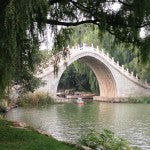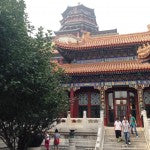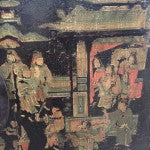
Sourcing some beautiful antiques and a trip to the Summer Palace
After a great visit to Shanghai with plenty of food for thought for future products, it was a short hop to Beijing on Tuesday to start the second part of my trip. This involved meeting up with a few of my favourite furniture and antique workshops – mainly to choose the pieces that we will ship prior to Christmas. In fact we already have one container lined up to ship from Beijing in a month or so – as soon as some more of our ‘Chinese Country’ range is completed here, so the next container will follow soon afterwards. This will be made up mainly of the antiques I chose during my visit this time around, along with more additions to our new ‘China Seasons’ range.
First on my list was the company that supplies many of our Chinese antiques, and who specialise in a classical, shiny lacquer finish that perhaps people in the UK are most familiar with when they think of Chinese furniture. Their collection always includes some great quality painted pieces from Shanxi and Gansu that still have much of their original finish and detail intact. These are treated with care – maintaining the aged detail but resealing each piece with a new varnish. Where the original finish on an old cabinet or table is either severely worn or perhaps unattractive, it will be stripped back and then refinished – often in red but also in more unusual lacquers such as blues and creams that give a fresher, more contemporary lift to these beautiful old pieces.
I also caught up with a new supplier that I had met for the first time at the Furniture Fair in Shanghai. Unlike most of the workshops in Beijing these days, this one still deals mainly in restoring antiques rather than concentrating more on producing new furniture. When I met up with them here and visited their warehouse I was pleased to see both that they had a large selection of antique furniture, and that the quality of the restoration and finish was excellent. In contrast to the other two suppliers that we tend to ship from in Beijing, their offering includes many elm and walnut pieces in a brown finish, mostly from Shanxi and Gansu, rather than painted or restored to give a natural, matt look.
|
The Jade Belt Bridge, Summer Palace |
Summer Palace, Beijing | Detail from Pingyao Display Cabinet | Antique Pingyao Display Cabinet |
They also have one or two quite rare and expensive pieces. This is not the ‘hanghuali or zitan’ furniture that I mentioned in a recent post, but rather unusual painted cabinets that are beautifully preserved with their original paintings. One example was a wonderful little display cabinet from the city of Pingyao in Shanxi province, with an upper open shelf and two doors. The style of the paintings on the doors is particular to furniture from Pingyao, depicting various figures set on a backdrop of traditional Chinese houses in faded creams, pinks and blues. The cabinet also featured a wonderful bottom panel in carved relief, its original heavy hardware and the old shelf and hidden compartment for valuables on the inside. Whilst not being the type of antique Chinese cabinet that would fetch tens of thousands of pounds at Sotheby’s, original pieces from Pingyao are becoming very rare these days – many having been shipped out of China years ago. As such this particular cabinet is one that will become increasingly sought after over the coming years.
I spent most of the following day with another of our main suppliers for antiques, which always has a great selection particularly from Shanxi, Qinghai and Gansu. This workshop’s speciality is in restoring antiques as sympathetically as possible. They choose only good quality pieces to start with and will then repair them as needed, but always keeping the original finish if possible and never use a thick, heavy lacquer or varnish. They will sometimes resize and refinish an antique if they think it will improve the final ‘look’, but even then will use natural, more subtle colours and matt finishes. In my view this maintains the old character and story behind each piece and the furniture we buy from them often turns out to be amongst my favourites in our own collection.
Along with their antiques we have been developing a small collection of newly produced furniture with them in a distressed blue and black finish. I was able to see the first finished pieces during my visit, which I was delighted with. We will be shipping these next month to arrive mid-November so look out for the new range on our website soon afterwards.
Over my final days here in Beijing I spent a morning at Panjiayuan flea market to pick up accessories to ship next month – mostly stoneware but also a few bronzes and some beautiful ‘Miao’ embroidery.
Lastly, having had a hectic but productive ten days or so of work, I managed to get out to the Summer Palace here in Beijing for a spot of sightseeing on my final day. It had been about 12 years since I last visited the palace, which was originally built by the emperor Qianlong in 1750 to honour his mother and then rebuilt by the dowager empress Cixi in 1886 after the Anglo-French alliance had destroyed most of it in 1860. The last time I came was during winter and the huge lake that it overlooks was frozen solid. It was great to see it at a different time of year – the lake busy with leisure boats zipping back and forth and flitting underneath the many beautiful pagodas and bridges.
Thousands of tourists walked around the huge complex of extraordinary temples and palace grounds that include Cixi’s living quarters and the awe inspiring Tower of the Buddhist Incense. Built high on a hill overlooking the lake and dominating the palace grounds, the tower houses one of the most valuable antiquities in China – a five metre high golden Buddha cast in the 16th century.
It was good to have some spare time to do what I rarely get to do on my visits out here and see more of the wonderful culture and history that Beijing has to offer. A great way to end a very rewarding trip.









Leave a comment